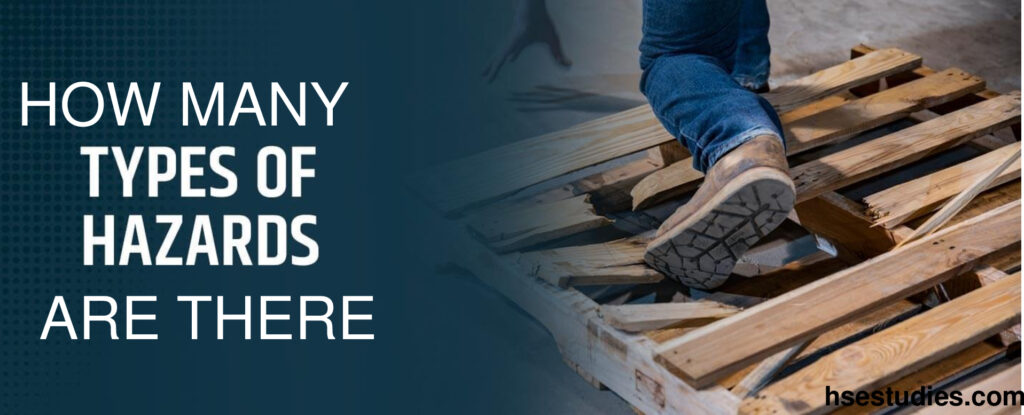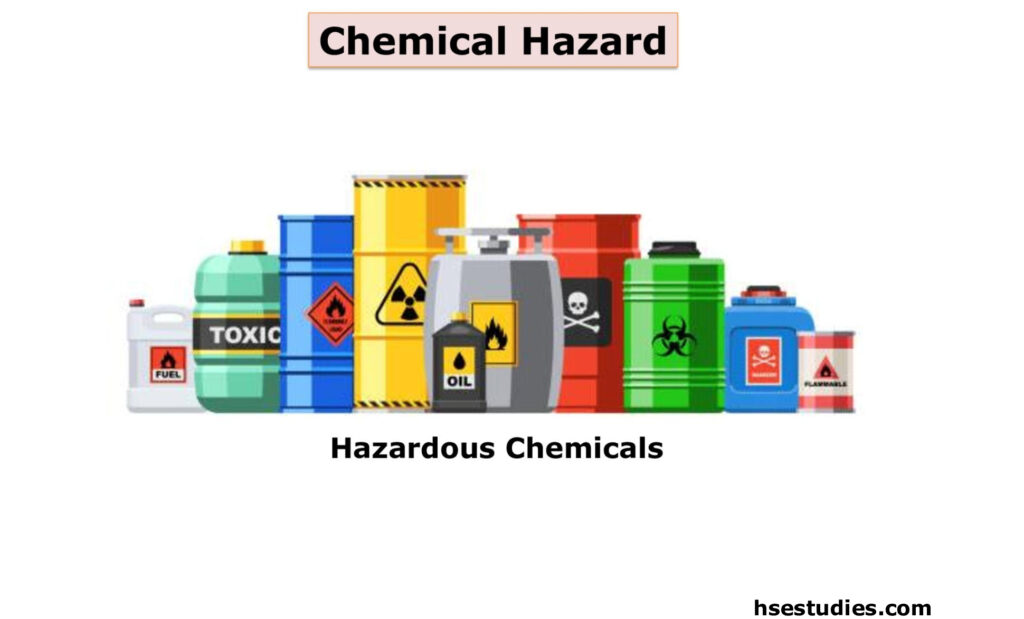Do you want to know ”How Many Types of Hazards Are There”? Then follow this article. Your concepts about workplace hazards will be cleared here!

Hazards in The Workplace
Every workplace has different types of hazards with the potential to cause harm to people, property, and the environment. Workers must understand the types of hazards. This will help them recognize workplace hazards. And it will be easy to mitigate them by implementing effective control measures while executing the assigned job in the workplace.
All workplaces are different from each other & due to this reason, workplace hazards differ from industry to industry, warehouse to warehouse, and job site to job site.
What Is The Definition of Hazard?

A hazard is something with the potential to cause harm to people, property, and the environment;
OR
Something that has the potential to cause harm to people, property, and the environment is called a hazard.
Hazards Examples; –
- Moving or rotating parts of machines or equipment.
- Excessive noise (more than 85db.
- Slippery / Dusty floor.
- Poorly designed workplace.
- Poor illumination at the workplace.
- Poor or awkward body posture.
- Excessive heat and humidity.
- Work at height.
- Manual load lifting.
- Fungi and bacteria.
- Toxic gases.
- Spillage of corrosive chemicals.
- Hazardous chemicals.
- Workload.
- Poor Housekeeping, etc.
How Many Types of Hazards Are There

To ensure the operation of the assigned tasks in the workplace, everyone should know how many types of hazards are there, According to workplace hazards. There are five 5-types of hazards as are listed below:
- Physical Hazard: Excessive noise, vibration, poor illumination, slippery floors, extreme temperature, etc.
- Chemical hazards in the workplace: hazardous dust, welding fumes, paints, hazardous gas, chemicals, etc.
- Biological Hazard: fungi, bacteria, viruses, insects, etc.
- Ergonomic Hazards in The Workplace: repetitive movements, awkward body posture, poorly designed workstations and tools, improper work methods or techniques, etc.
- Psychological Hazard: workload, the deadline for work completion, Shift work, bullying, Job dissatisfaction, mental harassment, Aggression, discrimination, etc.
Physical Hazard

Any hazards that come from environmental factors and can cause harm is called physical hazard. There are several examples of physical hazards such as excessive noise, vibration, poor illumination, slippery floors, obstructions in the walkways, radiation, high magnetic field, high temperature & humidity, height, etc.
Physical hazards are a common source of injuries to humans in the workplace, and they are perhaps unavoidable in some industries, such as construction, aluminum smelting, plant maintenance jobs, etc. Still, Over time, people have developed safety methods and procedures to manage the risks of physical hazards in the workplace.
To prevent or control the physical hazards in the workplace, below are some key points to follow
- Train or educate the employees properly so that they can be able to identify and avoid physical hazards in their working areas.
- Housekeeping must be maintained properly to avoid tripping hazards in the workplace.
- Avoid manual handling activity by using proper mechanical tools or equipment.
- Provide adequate rest breaks to the employees to avoid tiredness.
- Provide engineering controls to enclose the noisy areas or ensure Less exposure of employees in noisy areas.
- Provide good ventilation and illumination for employees in working areas.
- Reduce vibrations by applying engineering controls in the workplace.
- Proper PPE must be worn by employees to avoid physical hazards.
Chemical Hazard

Chemical hazards in the workplace are occupational hazards caused by exposure to hazardous chemicals that can lead to acute or chronic health effects on human health.
OR
The hazards arising from a solid, liquid, or gas element, compound, or mixture that could cause adverse health effects or environmental pollution are called chemical hazards, such as harmful dust, welding fumes, paints, hazardous gas, chemicals, etc.
Handling hazardous chemicals unsafely can lead to immediate adverse health effects such as skin and eye irritation, burn injury, etc. Moreover, there may also be long-term health effects from chemicals when employees are exposed to certain chemicals for a long duration. Long-term health effects include cancer, asthma, body organ damage, birth defectiveness, etc.
To protect the employees from exposure to chemical hazards in the workplace, below are some key points to follow.
- Provide training to employees relating to chemical hazards
- Use less hazardous chemicals instead of more hazardous ones
- Material Safety Data Sheet (MSDS) of chemicals to be adequately explained among employees, and it must be placed in the chemical storage area
- Chemicals handling at a workplace must be carried out by trained employees only.
- The label of chemicals must be stuck on the chemical container for identification.
- Adequate PPEs, such as rubber hand gloves, eye protection, protective clothing, respiratory protection, etc. to be worn by employees.
- Clean hands properly before eating food.
- Always store the chemicals in a safe place with proper ventilation and spill kits.
- Place suitable types of fire extinguishers (Foam type) near chemical storage.
All main points mentioned above must be complied with to avoid exposure to chemical hazards in the workplace.
Biological Hazard

The impact of living organisms on health, or living organisms that have the potential to pose a threat to human health, is called biological hazards.
OR
A biological hazard is an organic substance that can potentially cause a threat to human health (primarily) and other living organisms in the environment, such as fungi, bacteria, viruses, insects, etc.
Biological hazards can be dangerous for humans if inhaled, eaten, and come in contact with human skin. The workers who work in health care may have more chance of being exposed to biological hazards through contact with human bodily matter, such as blood, tissue, saliva, mucus, etc.
To protect workers from biological hazards (likely to cause disease) follow the below preventive measures.
- The organization shall ensure that the worker’s working amenities are provided with sufficient engineering and administrative controls such as proper ventilation and air purification/filtration.
- The disposal of organic waste must be done by the approved waste disposal method.
- Organic waste materials handling must be carried out with adequate compliance with personal protective equipment (PPE) such as hand gloves, masks, gowns, eye protection, etc.
- Ensure disinfecting surfaces and equipment from time to time
- Conduct health screening of employees to promote a healthy work environment
- Welfare facilities for workers must be built with a hand-wash facility.
Ergonomic Hazard

A hazard that can create physical stress because of repetitive work, improper work technique, and poorly designed workplace is an ergonomic hazard, such as repetitive movements, poor or awkward body posture, poorly designed workstations and tools, improper work methods or techniques, manual handling, etc. Ergonomic hazards in the workplace are common and could lead to serious personnel injury.
Ergonomics is the science of fitting the jobs to workers instead of getting the workers fit for the job. It focuses on designing workstations, tools & work processes for comfort and safety for workers. Ergonomics seeks to decrease fatigue and injuries by improving comfort, job satisfaction, and the safety of workers. Ergonomics is crucial because when you are doing a job and your body is stressed by an awkward posture, extreme temperature, or repeated movement can affect the musculoskeletal system. Your body may begin to have symptoms such as fatigue, discomfort, and pain, which can be the first signs of a musculoskeletal disorder. Hence, ergonomic hazards in the workplace must be recognized and controlled by effective safety measures.
To protect the employees from ergonomic hazards in the workplace, below are some key points to follow
- Train the employees in the course of ergonomic hazards in the workplace.
- Design the workstation properly to avoid awkward body posture.
- Provide tools according to the nature of the work.
- Develop the work method or techniques.
- Provide proper personal protective equipment (PPE), such as hand gloves safety shoes, eye protection, protective clothing, etc.
- Provide a variety of jobs to avoid ergonomic hazards in the workplace.
- Maintain a good housekeeping.
All main points mentioned above must be followed to avoid ergonomic hazards in the workplace.
Psychological Hazard

Psychological hazard is associated with organizational behavior, such as workload, the deadline for work completion, Shift work, bullying, Job dissatisfaction, mental harassment, Aggression, discrimination, depression, uncleared job roles, poor support from colleagues or organization, remote or lone work, poor interactions at workplace, poor organizational justice and improper or inadequate reward & recognition, etc.
Psychological hazards are usually identified or assessed by inspecting the work site on how workers carry out work and interact with each other, having conversations with workers individually or in the focus group, using surveys, and reviewing records such as incident reports, worker compensation claims, employees absenteeism, and employees turnover record.
The effect of psychological hazards may vary from one person to another and individual differences may mean that some workers are more susceptible to harm than others e.g. new and young, workers with illness, etc.
Assessment of psychological hazards at the workplace is to be done the same as physical and other hazards and required remedial controls to be implemented to eliminate or minimize the psychological hazards at the workplace.
Below are some key points that must be considered to eliminate or minimize psychological hazards at the workplace.
- Provide training relating to psychological hazards to employees to make them aware of the psychological hazards.
- Consider the impacts on employees when making a decision.
- Work planning to be improved whenever needed.
- Fair and respectful culture to be developed.
- Distribute the workload equally.
- Design the job properly.
- Provide support by allocating adequate resources.
- PPE is to be worn by employees where psychological hazards are not possible to eliminate or control.
Possible Effects of Hazards in the Workplace
Workplace hazards can result in unwanted accidents or incidents that might have led to personnel injuries or even death, property damage, & harmful effects on the environment.
For these reasons, Organizations must either eliminate the hazards from the workplace or control them by implementing effective control measures to save the workers from workplace injuries, protect the property from being damaged, and protect the environment from being polluted.
Unwanted accidents or incidents in the workplace can also lead to legal compensation and loss of an organizational reputation. Hence, organizations must implement remedial control measures in the workplace to eliminate or control hazards.
Organizations must consider the implementation of remedial controls against existing hazards at the workplace because by doing so, workplace hazards can be either eliminated or reduced to a lower / safer level of risk & once workplace hazards are controlled, the probability of accident or incident will be reduced & the morale of workers will be increased, which lead to boost productivity.
Conclusion:
Recognition of workplace hazards at the initial stage of the project and eliminating or controlling them by implementing effective control measures in the workplace is the most crucial thing that must be considered and implemented before starting a job in the workplace. Hazard mitigation with remedial control measures should be done to boost productivity. This will also help to protect against workplace injuries and accidents.
Q1 What Is Hazard?
Ans. A hazard is something with the potential to cause harm to people, property, and the environment.
Q2 What Are The Examples of Hazards?
Ans. Moving or rotating parts of machines or equipment.
Excessive noise (more than 85db.
Slippery / Dusty floor.
Poorly designed workplace.
Poor illumination at the workplace.
Poor or awkward body posture.
Excessive heat and humidity.
Work at height.
Manual load lifting.
Fungi and bacteria.
Toxic gases.
Spillage of corrosive chemicals.
Q3 What Are The Types of Hazards?
Ans. There are five types of hazards;
1) Physical hazard.
2) Chemical hazard.
3) Biological hazard.
4) Ergonomic hazard.
5) Psychological hazard.
